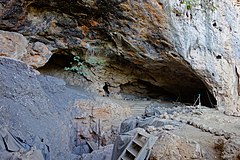Taforalt (Grotte des Pigeons)

The cave in September 2017
|
|
| Alternate name | Grotte des Pigeons |
|---|---|
| Location | near Taforalt village, northern Oujda region |
| Region | Morocco |
| Coordinates | 34°48′38″N 2°24′30″W / 34.81056°N 2.40833°WCoordinates: 34°48′38″N 2°24′30″W / 34.81056°N 2.40833°W |
| History | |
| Periods | Middle Paleolithic and Epipalaeolithic |
| Cultures | pre-Mousterian, Aterian, Iberomaurusian |
| Site notes | |
| Excavation dates | 1944–1947, 1950–1955, 1969-1977, 2003-2017 (ongoing) |
| Public access | No |
Taforalt (or Grotte des Pigeons) is a cave in northern Oujda, Morocco, and the oldest known cemetery in the world. It contained at least 35 Iberomaurusian human skeletons dated between 15,100 and 14,000 years ago, archaeological evidence for Iberomaurusian occupation between 22,500 and 12,500 years ago, as well as evidence for Aterian occupation as old as 85,000 years.
Grotte des Pigeons is a cave in eastern Morocco near the village of Taforalt. Human occupation and natural processes in the cave have produced a 10 m (32.8 ft) thick layer of archaeological material dating back to between 85,000 and 82,000 years ago. These occupation layers include pre-Mousterian, Aterian and Iberomaurusian industries, which date from the Middle Paleolithic and Epipaleolithic. Excavations of the Iberomaurusian layers dating from 15,100 to 14,000 years ago have recovered dozens of burials with some showing evidence of postmortem processing. Some show potential rituals with burials containing animal remains including horns, mandibles, a hoof, and a tooth. The deep and highly stratified cave floor has yielded hearths, lithics, and shell beads, among a variety of artefacts of varying ages. The dryness of the cave has contributed to the notable level of preservation found among the remains and artefacts.
The site is located around steep hills, rocky mountains, and the natural vegetation of the thermo-Mediterranean biozone including Tetraclinis articulate and Pinus halenpensis. The area itself is located in the Eastern part of Morocco near the community of Taforalt (Tafoughalt) at (34°48′38″ N, 2°24′30″ W). The large mouth of the cave opens to the northeast and has an area > 400 m2 (4,305.6 sq ft). Today the site lies around 40 km (24.9 mi) from the Mediterranean coast and at an altitude of 720 m (2,362.2 ft) above sea level.
The earliest layers of human habitation in the cave, dating from 85,000-82,000 years ago, contain evidence of a pre-Mousterian industry where no evidence of Levallois lithic technology is apparent. The following (newer) layers contain side scrapers, small radial Levallois cores, and thin, bifacially worked foliate points typical of the Aterian technological industries. These Aterian layers were dated to come from approximately 32,000 to >40,000 years ago, though other research has found a non-Levallois industry continuing at the site until 25,000 years ago. By about 21,000 years ago the Iberomaurusian industry, marked by microlithic backed bladelets, becomes the dominant archaeological material found at the site. These Iberomaurusian layers contain microlithics, ostrich egg shells, potentially ritualized primary and secondary burials, and a notable increase in land snail remains indicating a shift in dietary practices.
...
Wikipedia

